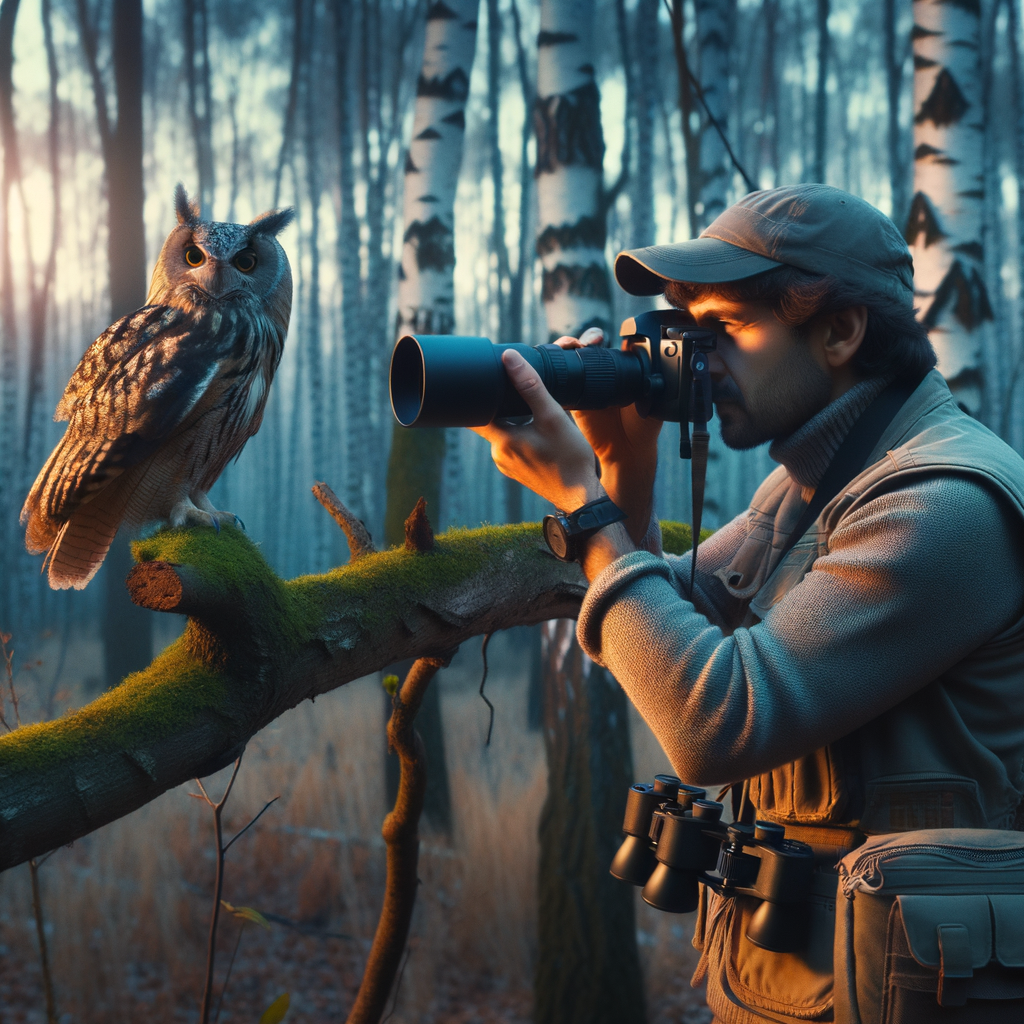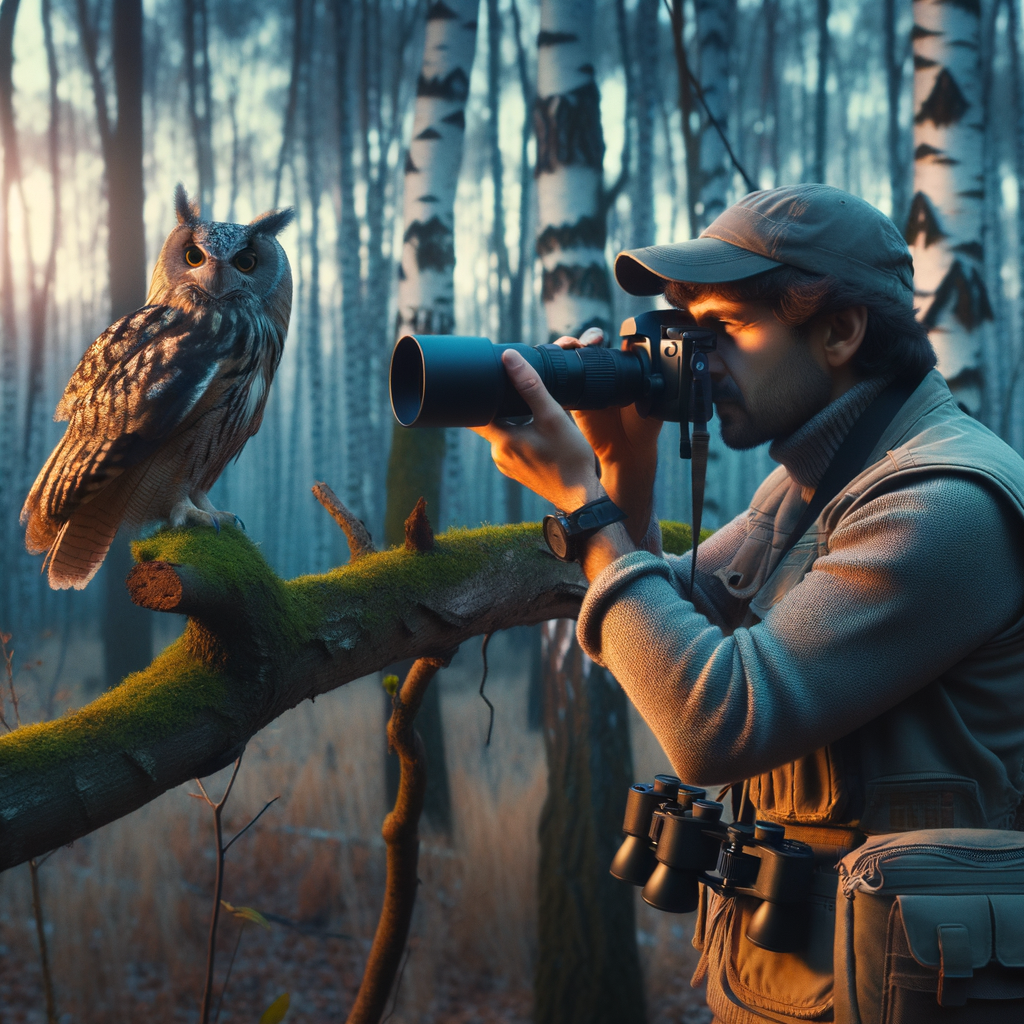
Introduction to Owling
-
- What is Owling?
Owling is the activity of observing and studying owls in their natural habitat. It involves going out at night when owls are most active. Owling can be a fun and educational hobby for people of all ages.
-
- The Importance of Owling
Owling is important for several reasons:
-
- Conservation: By observing owls, we can learn more about their habits and needs. This helps in protecting their habitats and ensuring their survival.
- Education: Owling teaches us about the environment and the role owls play in it. It can inspire a love for nature and wildlife.
- Enjoyment: Many people find joy and relaxation in watching these mysterious birds. It can be a peaceful way to connect with nature.
Owling Techniques
Basic Techniques
-
Owl Behavior
They are mostly nocturnal, which means they are active at night. To understand their behavior, it’s important to know their habits. Owls hunt for food in the dark and rest during the day.
Did you know? Owls have excellent night vision and can rotate their heads up to 270 degrees! This helps them spot prey even in the dark.
Owl Behavior Description Nocturnal Active at night Silent Flight Fly quietly to catch prey Head Rotation Can turn head up to 270 degrees -
Identifying Owl Calls
Learning these calls can help you identify owls in the wild. For example, the Great Horned Owl has a deep, hooting call, while the Barn Owl makes a screeching sound.
Listening to owl calls can be exciting. Try to match the calls you hear with recordings from reliable sources like Wikipedia.
Here are some common owl calls:
- Great Horned Owl: Deep hoot
- Barn Owl: Loud screech
- Eastern Screech-Owl: Trill or whinny
Advanced Techniques
-
Spotting Owls in Flight
Owls are known for their silent flight, which makes them hard to detect. Here are some tips to help you:
- Look for silhouettes: Owls have a distinct shape with broad wings and a rounded head. Watch the sky during dawn or dusk when they are most active.
- Listen for wing sounds: While owls are quiet, you might still hear a faint whoosh of their wings.
- Use binoculars: A good pair of binoculars can help you spot owls from a distance.
According to a study, owls’ silent flight is due to the unique structure of their feathers. Learn more about owl feathers on Wikipedia.
-
Identifying Owl Species by Sight
Identifying different owl species can be exciting. Here are some key features to look for:
Owl Species Key Features Barn Owl Heart-shaped face, white underparts Great Horned Owl Large size, ear tufts Snowy Owl White feathers, yellow eyes Using a field guide can also help you identify owls. These guides provide pictures and descriptions of various species.
For more detailed information, you can visit Wikipedia’s list of owl species.
How to Owl: A Step-by-Step Guide
-
Choosing the Right Time and Place
Owls are most active at night, especially during dusk and dawn. These times are best for spotting them. Look for places like forests, parks, and fields where owls are known to live.
Did you know? Owls can be found on every continent except Antarctica. This means you can find them almost anywhere!
-
What Equipment to Bring
Having the right equipment can make your owling experience better. Here are some items to consider:
- Binoculars: These help you see owls from a distance.
- Flashlight: Use a red filter to avoid scaring the owls.
- Notebook and Pen: Jot down your observations.
- Camera: Capture photos of the owls you spot.
-
How to Stay Safe While Owling
Safety is important when you are out at night. Here are some tips to keep in mind:
- Bring a Friend: It’s safer and more fun with company.
- Wear Reflective Clothing: This helps others see you in the dark.
- Stay on Marked Trails: Avoid getting lost by sticking to known paths.
- Check the Weather: Make sure the weather is safe for an outdoor trip.
Birdwatching Owls: Tips and Tricks
Nocturnal Birdwatching
Owls are fascinating creatures, especially when seen at night. Here are some tips to help you enjoy nocturnal birdwatching.
-
Best Time for Owling
The best time to go owling is during the night. Owls are nocturnal, which means they are most active after sunset and before sunrise. The hours just after dusk and just before dawn are ideal. During these times, you are more likely to hear their calls and see them hunting.
-
How to Spot Owls in the Dark
Spotting owls in the dark can be tricky, but here are some tips:
-
- Listen for Calls: Owls are known for their distinct calls. By listening carefully, you can often locate them.
- Use a Red Light: A red flashlight is less likely to startle owls. It helps you see without disturbing them.
- Look for Movement: Owls have a unique flying pattern. Watch for silent, gliding movements in the trees.
| Time | Activity |
|---|---|
| After Sunset | Owls start to become active, listen for calls |
| Midnight | Peak activity, best time to spot owls |
| Before Sunrise | Owls are still active, good time for sightings |
Owl Photography Tips
-
- The Right Camera
A DSLR or mirrorless camera with a fast shutter speed and good low-light performance works best. Look for cameras with high ISO capabilities to capture clear images in dim light. Popular models include the Canon EOS R6 and the Nikon Z6. These cameras are known for their excellent image quality and fast autofocus.
-
- Photographing Owls in Flight
Capturing owls in flight can be challenging but rewarding. To get the best shots, use a fast shutter speed, around 1/1000th of a second or faster. This helps freeze the motion of the owl. Set your camera to continuous shooting mode to take multiple photos quickly. This increases your chances of getting the perfect shot. Additionally, practice panning your camera to follow the owl’s movement smoothly.
| Tip | Details |
|---|---|
| Camera Type | DSLR or Mirrorless |
| Shutter Speed | 1/1000th of a second or faster |
| ISO Settings | High ISO for low light |
| Continuous Shooting | Use to capture multiple shots |
Patience is key when photographing owls. They can be elusive and may take time to appear. Stay quiet and still to avoid scaring them away. Happy photographing!
Identifying Owl Species
-
Common Owl Species
There are many types of owls around the world. Here are some of the most common species:
- Barn Owl: Known for its heart-shaped face and white feathers. They are found almost everywhere except polar and desert regions.
- Great Horned Owl: Recognizable by its ear tufts or “horns.” They live in both North and South America.
- Snowy Owl: Famous for its white feathers. These owls live in the Arctic regions.
- Eastern Screech Owl: Small and camouflaged, they are found in North America. They make a trilling sound.
-
Rare and Endangered Owl Species
Some owls are rare and endangered. These species need our help to survive:
- Blakiston’s Fish Owl: The largest owl species. They live in Russia, China, and Japan. They are endangered due to habitat loss.
- Spotted Owl: Found in North America’s old forests. They are threatened by logging and habitat destruction.
- Forest Owlet: A small owl found in central India. It was thought to be extinct but was rediscovered in 1997.
- Philippine Eagle-Owl: Native to the Philippines. Deforestation has made them endangered.
| Owl Species | Habitat | Conservation Status |
|---|---|---|
| Barn Owl | Worldwide except polar and desert regions | Least Concern |
| Great Horned Owl | North and South America | Least Concern |
| Snowy Owl | Arctic regions | Least Concern |
| Eastern Screech Owl | North America | Least Concern |
| Blakiston’s Fish Owl | Russia, China, Japan | Endangered |
| Spotted Owl | North America’s old forests | Near Threatened |
| Forest Owlet | Central India | Critically Endangered |
| Philippine Eagle-Owl | Philippines | Endangered |
Understanding these species helps us protect them. Learn more about owls on Wikipedia.
Owling Equipment
Essential Gear for Owling
When you go owling, having the right equipment is very important. Here are some items you should bring:
- Binoculars: These help you see owls from far away. Look for ones with good magnification.
- Flashlight: A flashlight helps you see in the dark. Red filters are best because they don’t scare the owls.
- Notebook: Write down what you see. This helps you learn more about owls.
- Warm Clothes: It can get cold at night. Wear layers to stay warm.
- Field Guide: A book about owls can help you identify different species.
Recommended Brands and Products
There are many brands that make good owling gear. Here are some recommendations:
| Item | Brand | Product |
|---|---|---|
| Binoculars | Nikon | Nikon Prostaff 3S |
| Flashlight | Streamlight | Streamlight ProTac HL-X |
| Notebook | Moleskine | Moleskine Classic Notebook |
| Warm Clothes | Columbia | Columbia Fleece Jacket |
| Field Guide | National Geographic | National Geographic Field Guide to the Birds of North America |
Using the right gear makes owling more fun and successful. Happy owling!
Owling Safety Tips
-
Respecting Wildlife
When you go owling, it’s important to respect the owls and their habitat. Owls are wild animals and can be easily disturbed. Here are some tips to help you respect wildlife:
- Keep Your Distance: Always stay at least 100 feet away from an owl. This helps keep them calm and safe.
- Be Quiet: Speak softly and avoid making loud noises. Owls have sensitive hearing and can be scared away easily.
- Do Not Use Flash Photography: Flash can startle owls and cause them stress. Use a flashlight with a red filter if you need to see in the dark.
-
Staying Safe in the Outdoors
Owling often takes place at night, which can present some safety challenges. Here are some tips to ensure you stay safe while enjoying your owling adventure:
- Bring a Buddy: It’s always safer to go owling with a friend. This way, you can help each other if something goes wrong.
- Wear Appropriate Clothing: Dress in layers and wear sturdy shoes. The weather can change quickly, and you might need to walk on rough terrain.
- Carry a First Aid Kit: Accidents can happen. Having a first aid kit can help you deal with minor injuries.
- Know Your Location: Familiarize yourself with the area. Carry a map and a compass or GPS device to avoid getting lost.
Conclusion
-
Recap of Owling Techniques and Tips
Owling is a fun and exciting activity. We learned several techniques to help us spot owls. Be quiet and patient. Use a flashlight with a red filter to avoid scaring the owls. Listen for their calls, as this can help you find them.
Here are some key tips:
- Be patient and quiet.
- Use a red-filtered flashlight.
- Listen for owl calls.
- Go out at dusk or dawn.
-
Encouragement for Future Owling Adventures
Now that you know the basics, it’s time to go on your own owling adventure! Every trip is a chance to learn something new. Don’t be discouraged if you don’t see an owl right away. Keep trying, and enjoy the experience of being in nature.






